Kuwait Petroleum: Achieving Sustainable Competitive Advantage
VerifiedAdded on 2023/06/10
|10
|2408
|128
Report
AI Summary
This report analyzes the business-level strategies within Kuwait's petroleum industry, focusing on achieving a sustainable competitive advantage. It examines the industry's environment, key players like Kuwait Petroleum Corporation (KPC), and the competitive forces at play, including rivalry, new entrants, buyer power, supplier power, and substitute threats. The report emphasizes the importance of resources and capabilities, utilizing the VRIN framework (Valuable, Rare, Inimitable, Non-substitutable) to assess their impact. Furthermore, it discusses strategies such as cost leadership, differentiation, and focus, highlighting how companies can leverage these to gain a competitive edge. The analysis concludes that a thorough understanding of the competitive landscape, coupled with strategic resource management and capability development, is crucial for long-term growth and sustainability in Kuwait's petroleum sector. Desklib provides access to this full report and numerous other solved assignments for students.
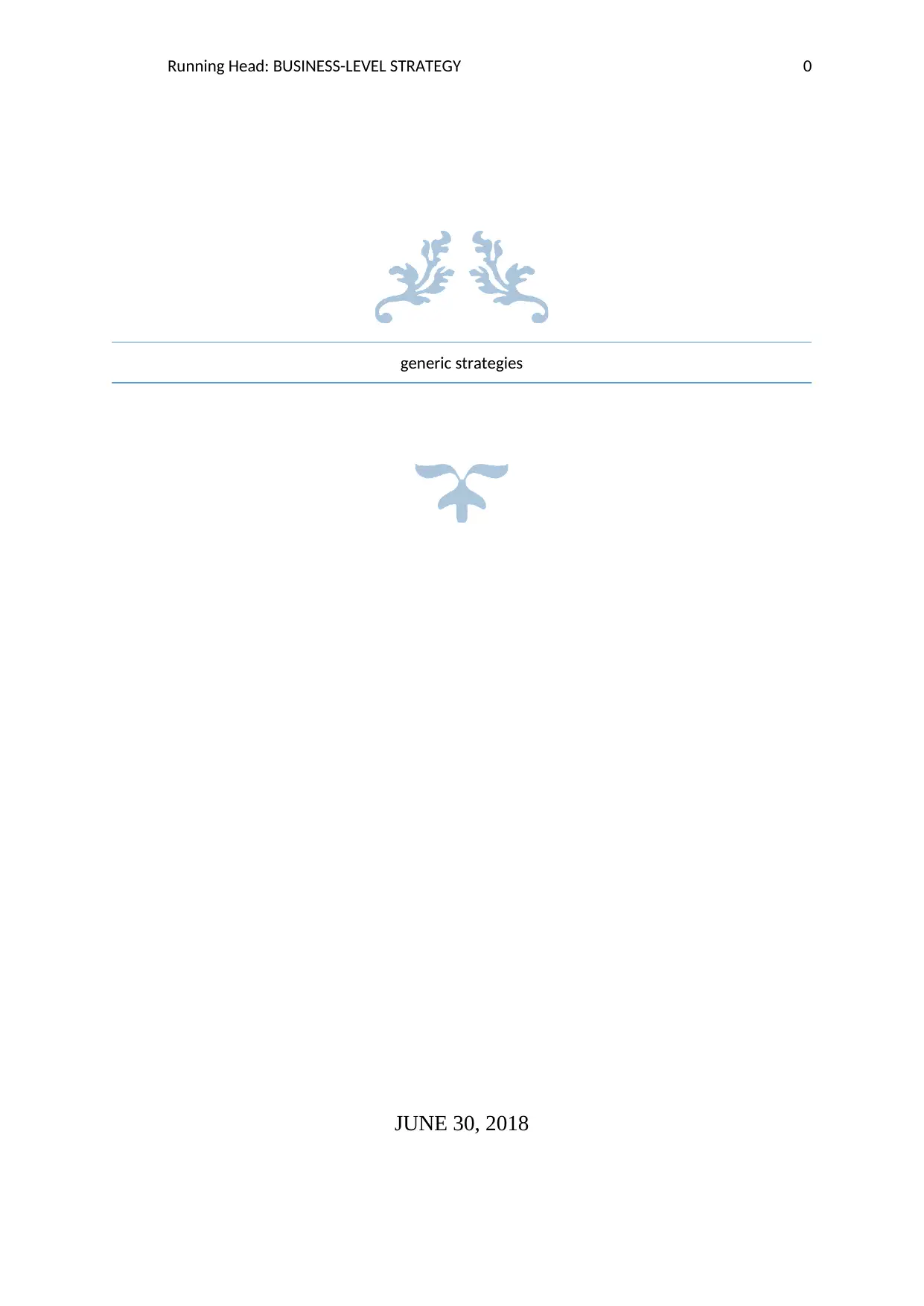
Running Head: BUSINESS-LEVEL STRATEGY 0
generic strategies
JUNE 30, 2018
generic strategies
JUNE 30, 2018
Paraphrase This Document
Need a fresh take? Get an instant paraphrase of this document with our AI Paraphraser
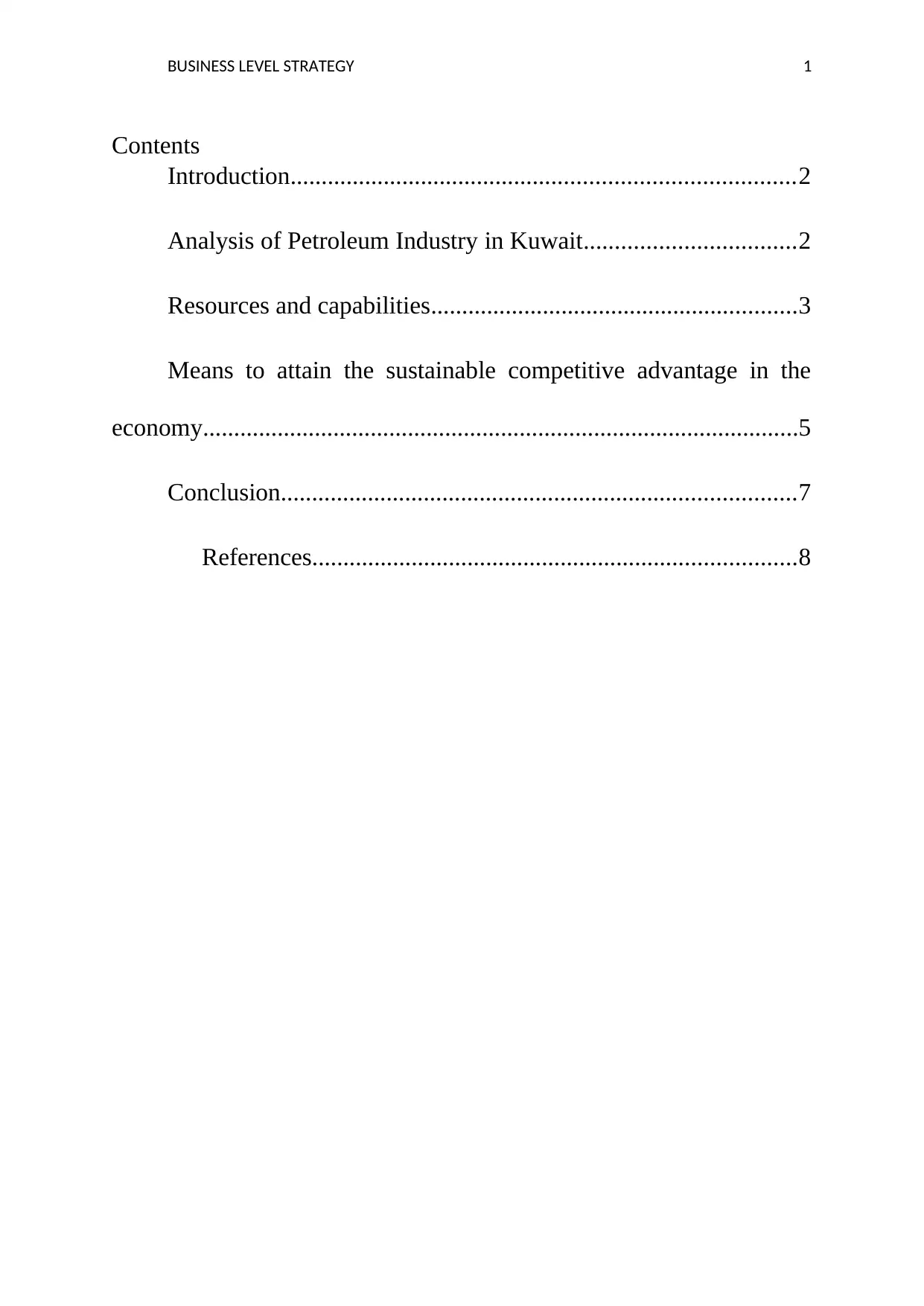
BUSINESS LEVEL STRATEGY 1
Contents
Introduction.................................................................................2
Analysis of Petroleum Industry in Kuwait..................................2
Resources and capabilities...........................................................3
Means to attain the sustainable competitive advantage in the
economy................................................................................................5
Conclusion...................................................................................7
References..............................................................................8
Contents
Introduction.................................................................................2
Analysis of Petroleum Industry in Kuwait..................................2
Resources and capabilities...........................................................3
Means to attain the sustainable competitive advantage in the
economy................................................................................................5
Conclusion...................................................................................7
References..............................................................................8
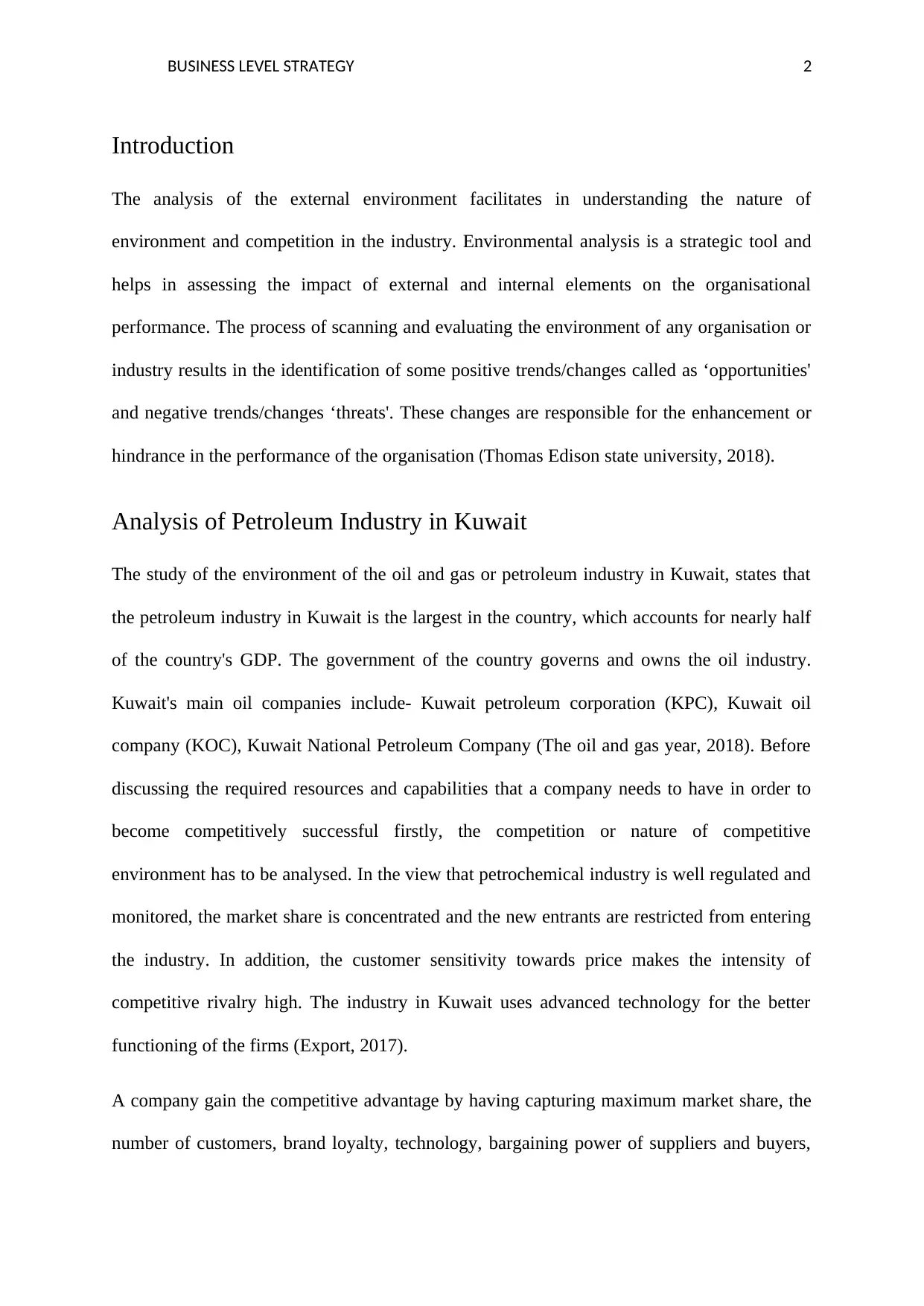
BUSINESS LEVEL STRATEGY 2
Introduction
The analysis of the external environment facilitates in understanding the nature of
environment and competition in the industry. Environmental analysis is a strategic tool and
helps in assessing the impact of external and internal elements on the organisational
performance. The process of scanning and evaluating the environment of any organisation or
industry results in the identification of some positive trends/changes called as ‘opportunities'
and negative trends/changes ‘threats'. These changes are responsible for the enhancement or
hindrance in the performance of the organisation (Thomas Edison state university, 2018).
Analysis of Petroleum Industry in Kuwait
The study of the environment of the oil and gas or petroleum industry in Kuwait, states that
the petroleum industry in Kuwait is the largest in the country, which accounts for nearly half
of the country's GDP. The government of the country governs and owns the oil industry.
Kuwait's main oil companies include- Kuwait petroleum corporation (KPC), Kuwait oil
company (KOC), Kuwait National Petroleum Company (The oil and gas year, 2018). Before
discussing the required resources and capabilities that a company needs to have in order to
become competitively successful firstly, the competition or nature of competitive
environment has to be analysed. In the view that petrochemical industry is well regulated and
monitored, the market share is concentrated and the new entrants are restricted from entering
the industry. In addition, the customer sensitivity towards price makes the intensity of
competitive rivalry high. The industry in Kuwait uses advanced technology for the better
functioning of the firms (Export, 2017).
A company gain the competitive advantage by having capturing maximum market share, the
number of customers, brand loyalty, technology, bargaining power of suppliers and buyers,
Introduction
The analysis of the external environment facilitates in understanding the nature of
environment and competition in the industry. Environmental analysis is a strategic tool and
helps in assessing the impact of external and internal elements on the organisational
performance. The process of scanning and evaluating the environment of any organisation or
industry results in the identification of some positive trends/changes called as ‘opportunities'
and negative trends/changes ‘threats'. These changes are responsible for the enhancement or
hindrance in the performance of the organisation (Thomas Edison state university, 2018).
Analysis of Petroleum Industry in Kuwait
The study of the environment of the oil and gas or petroleum industry in Kuwait, states that
the petroleum industry in Kuwait is the largest in the country, which accounts for nearly half
of the country's GDP. The government of the country governs and owns the oil industry.
Kuwait's main oil companies include- Kuwait petroleum corporation (KPC), Kuwait oil
company (KOC), Kuwait National Petroleum Company (The oil and gas year, 2018). Before
discussing the required resources and capabilities that a company needs to have in order to
become competitively successful firstly, the competition or nature of competitive
environment has to be analysed. In the view that petrochemical industry is well regulated and
monitored, the market share is concentrated and the new entrants are restricted from entering
the industry. In addition, the customer sensitivity towards price makes the intensity of
competitive rivalry high. The industry in Kuwait uses advanced technology for the better
functioning of the firms (Export, 2017).
A company gain the competitive advantage by having capturing maximum market share, the
number of customers, brand loyalty, technology, bargaining power of suppliers and buyers,
⊘ This is a preview!⊘
Do you want full access?
Subscribe today to unlock all pages.

Trusted by 1+ million students worldwide
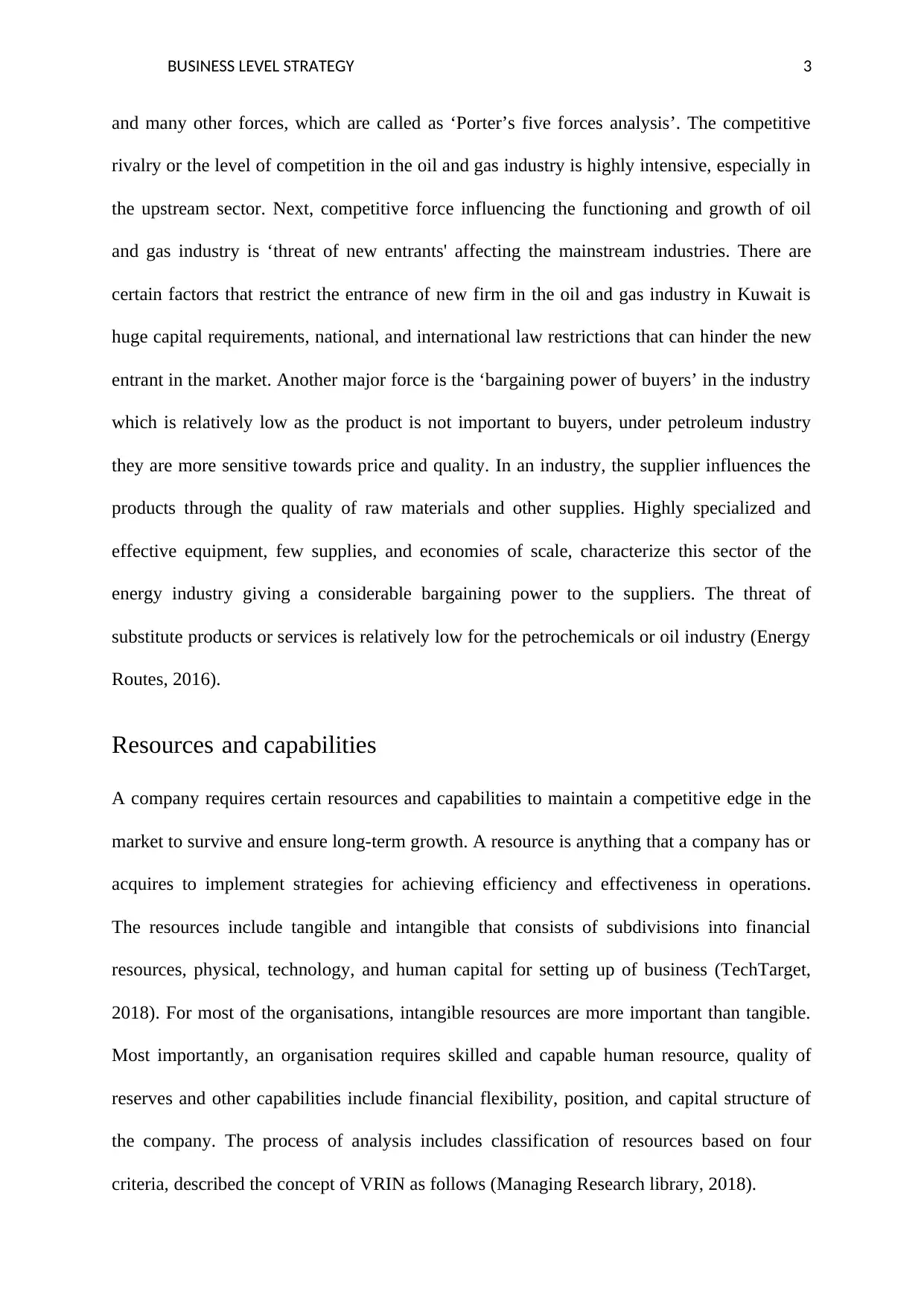
BUSINESS LEVEL STRATEGY 3
and many other forces, which are called as ‘Porter’s five forces analysis’. The competitive
rivalry or the level of competition in the oil and gas industry is highly intensive, especially in
the upstream sector. Next, competitive force influencing the functioning and growth of oil
and gas industry is ‘threat of new entrants' affecting the mainstream industries. There are
certain factors that restrict the entrance of new firm in the oil and gas industry in Kuwait is
huge capital requirements, national, and international law restrictions that can hinder the new
entrant in the market. Another major force is the ‘bargaining power of buyers’ in the industry
which is relatively low as the product is not important to buyers, under petroleum industry
they are more sensitive towards price and quality. In an industry, the supplier influences the
products through the quality of raw materials and other supplies. Highly specialized and
effective equipment, few supplies, and economies of scale, characterize this sector of the
energy industry giving a considerable bargaining power to the suppliers. The threat of
substitute products or services is relatively low for the petrochemicals or oil industry (Energy
Routes, 2016).
Resources and capabilities
A company requires certain resources and capabilities to maintain a competitive edge in the
market to survive and ensure long-term growth. A resource is anything that a company has or
acquires to implement strategies for achieving efficiency and effectiveness in operations.
The resources include tangible and intangible that consists of subdivisions into financial
resources, physical, technology, and human capital for setting up of business (TechTarget,
2018). For most of the organisations, intangible resources are more important than tangible.
Most importantly, an organisation requires skilled and capable human resource, quality of
reserves and other capabilities include financial flexibility, position, and capital structure of
the company. The process of analysis includes classification of resources based on four
criteria, described the concept of VRIN as follows (Managing Research library, 2018).
and many other forces, which are called as ‘Porter’s five forces analysis’. The competitive
rivalry or the level of competition in the oil and gas industry is highly intensive, especially in
the upstream sector. Next, competitive force influencing the functioning and growth of oil
and gas industry is ‘threat of new entrants' affecting the mainstream industries. There are
certain factors that restrict the entrance of new firm in the oil and gas industry in Kuwait is
huge capital requirements, national, and international law restrictions that can hinder the new
entrant in the market. Another major force is the ‘bargaining power of buyers’ in the industry
which is relatively low as the product is not important to buyers, under petroleum industry
they are more sensitive towards price and quality. In an industry, the supplier influences the
products through the quality of raw materials and other supplies. Highly specialized and
effective equipment, few supplies, and economies of scale, characterize this sector of the
energy industry giving a considerable bargaining power to the suppliers. The threat of
substitute products or services is relatively low for the petrochemicals or oil industry (Energy
Routes, 2016).
Resources and capabilities
A company requires certain resources and capabilities to maintain a competitive edge in the
market to survive and ensure long-term growth. A resource is anything that a company has or
acquires to implement strategies for achieving efficiency and effectiveness in operations.
The resources include tangible and intangible that consists of subdivisions into financial
resources, physical, technology, and human capital for setting up of business (TechTarget,
2018). For most of the organisations, intangible resources are more important than tangible.
Most importantly, an organisation requires skilled and capable human resource, quality of
reserves and other capabilities include financial flexibility, position, and capital structure of
the company. The process of analysis includes classification of resources based on four
criteria, described the concept of VRIN as follows (Managing Research library, 2018).
Paraphrase This Document
Need a fresh take? Get an instant paraphrase of this document with our AI Paraphraser
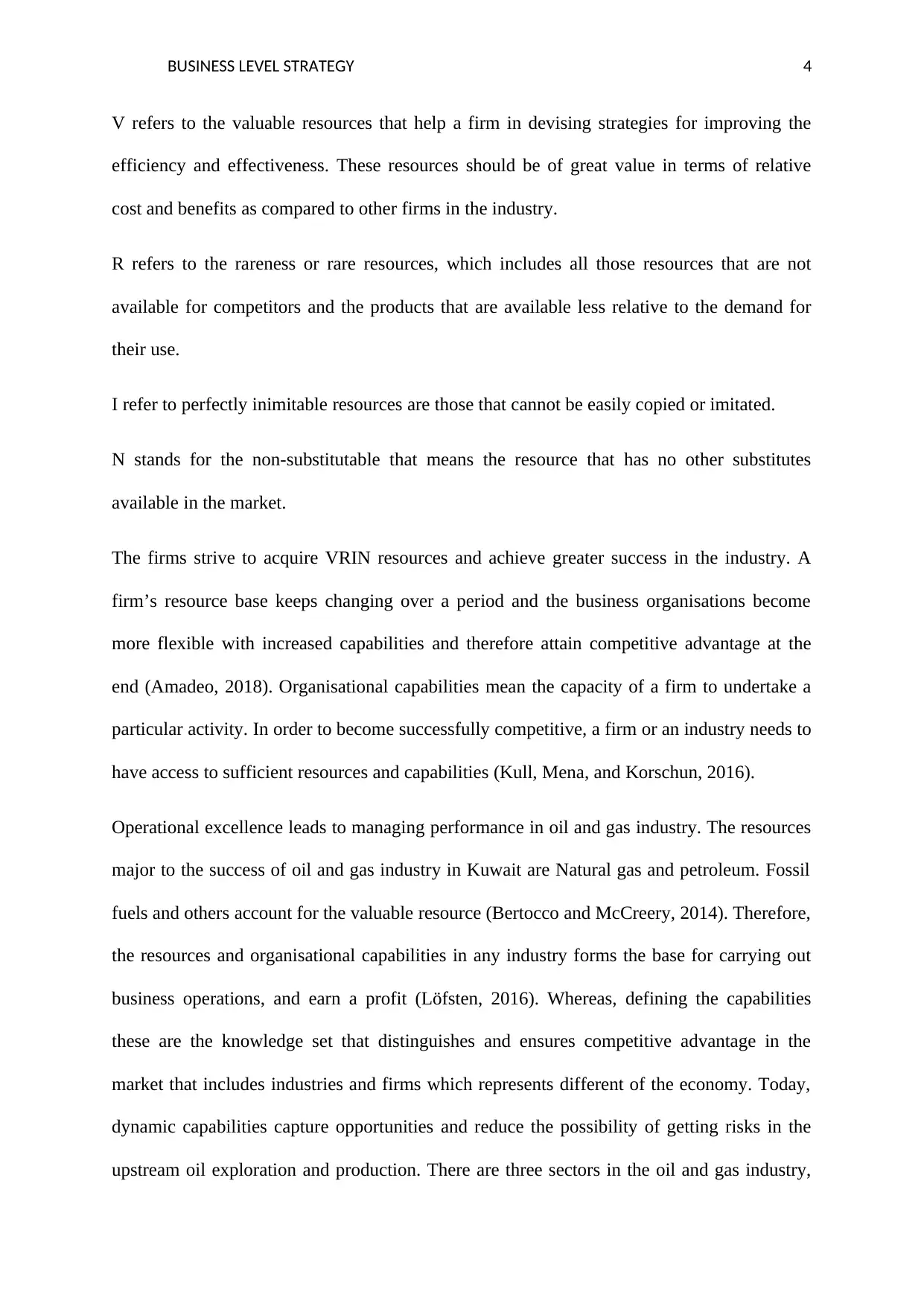
BUSINESS LEVEL STRATEGY 4
V refers to the valuable resources that help a firm in devising strategies for improving the
efficiency and effectiveness. These resources should be of great value in terms of relative
cost and benefits as compared to other firms in the industry.
R refers to the rareness or rare resources, which includes all those resources that are not
available for competitors and the products that are available less relative to the demand for
their use.
I refer to perfectly inimitable resources are those that cannot be easily copied or imitated.
N stands for the non-substitutable that means the resource that has no other substitutes
available in the market.
The firms strive to acquire VRIN resources and achieve greater success in the industry. A
firm’s resource base keeps changing over a period and the business organisations become
more flexible with increased capabilities and therefore attain competitive advantage at the
end (Amadeo, 2018). Organisational capabilities mean the capacity of a firm to undertake a
particular activity. In order to become successfully competitive, a firm or an industry needs to
have access to sufficient resources and capabilities (Kull, Mena, and Korschun, 2016).
Operational excellence leads to managing performance in oil and gas industry. The resources
major to the success of oil and gas industry in Kuwait are Natural gas and petroleum. Fossil
fuels and others account for the valuable resource (Bertocco and McCreery, 2014). Therefore,
the resources and organisational capabilities in any industry forms the base for carrying out
business operations, and earn a profit (Löfsten, 2016). Whereas, defining the capabilities
these are the knowledge set that distinguishes and ensures competitive advantage in the
market that includes industries and firms which represents different of the economy. Today,
dynamic capabilities capture opportunities and reduce the possibility of getting risks in the
upstream oil exploration and production. There are three sectors in the oil and gas industry,
V refers to the valuable resources that help a firm in devising strategies for improving the
efficiency and effectiveness. These resources should be of great value in terms of relative
cost and benefits as compared to other firms in the industry.
R refers to the rareness or rare resources, which includes all those resources that are not
available for competitors and the products that are available less relative to the demand for
their use.
I refer to perfectly inimitable resources are those that cannot be easily copied or imitated.
N stands for the non-substitutable that means the resource that has no other substitutes
available in the market.
The firms strive to acquire VRIN resources and achieve greater success in the industry. A
firm’s resource base keeps changing over a period and the business organisations become
more flexible with increased capabilities and therefore attain competitive advantage at the
end (Amadeo, 2018). Organisational capabilities mean the capacity of a firm to undertake a
particular activity. In order to become successfully competitive, a firm or an industry needs to
have access to sufficient resources and capabilities (Kull, Mena, and Korschun, 2016).
Operational excellence leads to managing performance in oil and gas industry. The resources
major to the success of oil and gas industry in Kuwait are Natural gas and petroleum. Fossil
fuels and others account for the valuable resource (Bertocco and McCreery, 2014). Therefore,
the resources and organisational capabilities in any industry forms the base for carrying out
business operations, and earn a profit (Löfsten, 2016). Whereas, defining the capabilities
these are the knowledge set that distinguishes and ensures competitive advantage in the
market that includes industries and firms which represents different of the economy. Today,
dynamic capabilities capture opportunities and reduce the possibility of getting risks in the
upstream oil exploration and production. There are three sectors in the oil and gas industry,
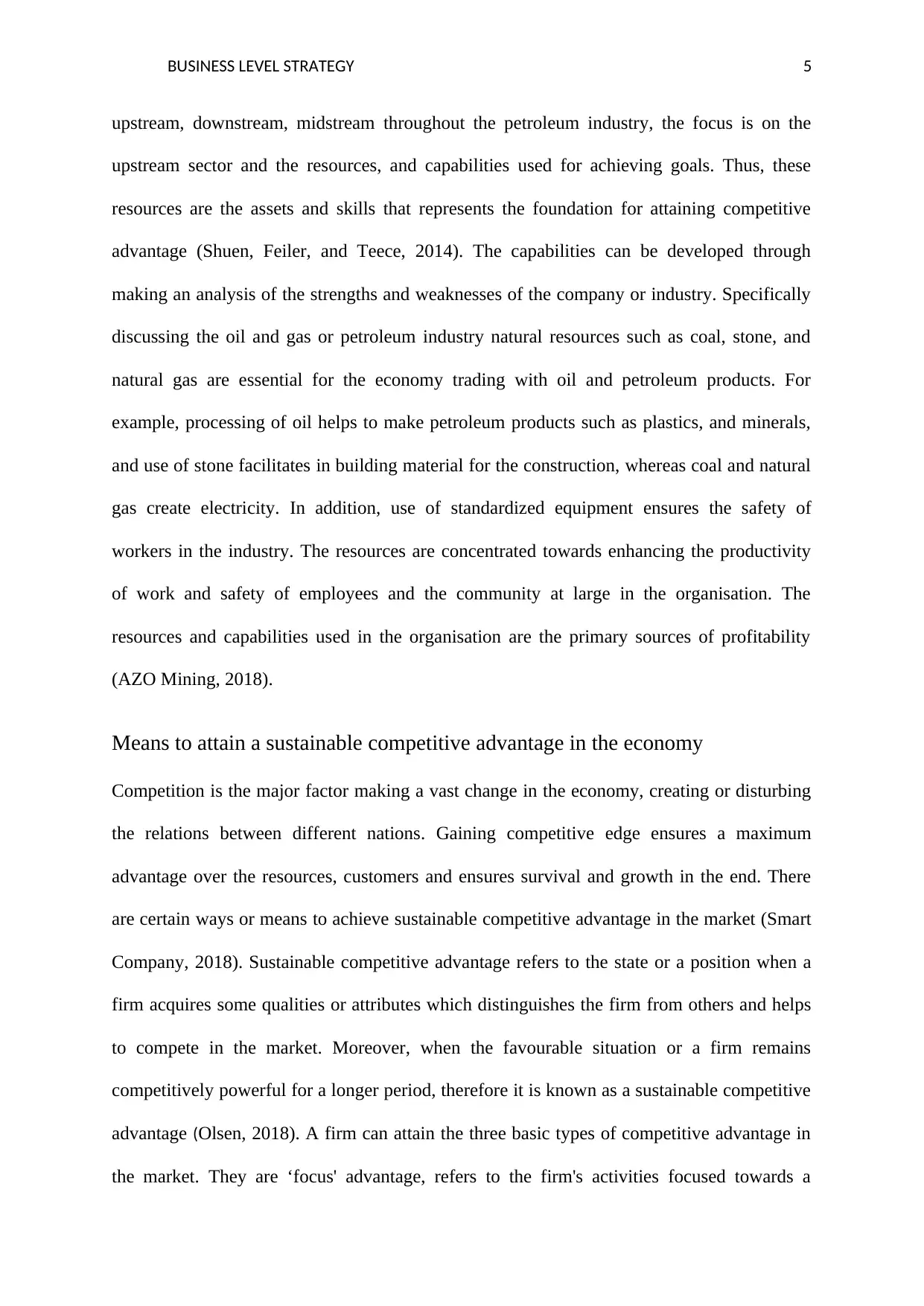
BUSINESS LEVEL STRATEGY 5
upstream, downstream, midstream throughout the petroleum industry, the focus is on the
upstream sector and the resources, and capabilities used for achieving goals. Thus, these
resources are the assets and skills that represents the foundation for attaining competitive
advantage (Shuen, Feiler, and Teece, 2014). The capabilities can be developed through
making an analysis of the strengths and weaknesses of the company or industry. Specifically
discussing the oil and gas or petroleum industry natural resources such as coal, stone, and
natural gas are essential for the economy trading with oil and petroleum products. For
example, processing of oil helps to make petroleum products such as plastics, and minerals,
and use of stone facilitates in building material for the construction, whereas coal and natural
gas create electricity. In addition, use of standardized equipment ensures the safety of
workers in the industry. The resources are concentrated towards enhancing the productivity
of work and safety of employees and the community at large in the organisation. The
resources and capabilities used in the organisation are the primary sources of profitability
(AZO Mining, 2018).
Means to attain a sustainable competitive advantage in the economy
Competition is the major factor making a vast change in the economy, creating or disturbing
the relations between different nations. Gaining competitive edge ensures a maximum
advantage over the resources, customers and ensures survival and growth in the end. There
are certain ways or means to achieve sustainable competitive advantage in the market (Smart
Company, 2018). Sustainable competitive advantage refers to the state or a position when a
firm acquires some qualities or attributes which distinguishes the firm from others and helps
to compete in the market. Moreover, when the favourable situation or a firm remains
competitively powerful for a longer period, therefore it is known as a sustainable competitive
advantage (Olsen, 2018). A firm can attain the three basic types of competitive advantage in
the market. They are ‘focus' advantage, refers to the firm's activities focused towards a
upstream, downstream, midstream throughout the petroleum industry, the focus is on the
upstream sector and the resources, and capabilities used for achieving goals. Thus, these
resources are the assets and skills that represents the foundation for attaining competitive
advantage (Shuen, Feiler, and Teece, 2014). The capabilities can be developed through
making an analysis of the strengths and weaknesses of the company or industry. Specifically
discussing the oil and gas or petroleum industry natural resources such as coal, stone, and
natural gas are essential for the economy trading with oil and petroleum products. For
example, processing of oil helps to make petroleum products such as plastics, and minerals,
and use of stone facilitates in building material for the construction, whereas coal and natural
gas create electricity. In addition, use of standardized equipment ensures the safety of
workers in the industry. The resources are concentrated towards enhancing the productivity
of work and safety of employees and the community at large in the organisation. The
resources and capabilities used in the organisation are the primary sources of profitability
(AZO Mining, 2018).
Means to attain a sustainable competitive advantage in the economy
Competition is the major factor making a vast change in the economy, creating or disturbing
the relations between different nations. Gaining competitive edge ensures a maximum
advantage over the resources, customers and ensures survival and growth in the end. There
are certain ways or means to achieve sustainable competitive advantage in the market (Smart
Company, 2018). Sustainable competitive advantage refers to the state or a position when a
firm acquires some qualities or attributes which distinguishes the firm from others and helps
to compete in the market. Moreover, when the favourable situation or a firm remains
competitively powerful for a longer period, therefore it is known as a sustainable competitive
advantage (Olsen, 2018). A firm can attain the three basic types of competitive advantage in
the market. They are ‘focus' advantage, refers to the firm's activities focused towards a
⊘ This is a preview!⊘
Do you want full access?
Subscribe today to unlock all pages.

Trusted by 1+ million students worldwide
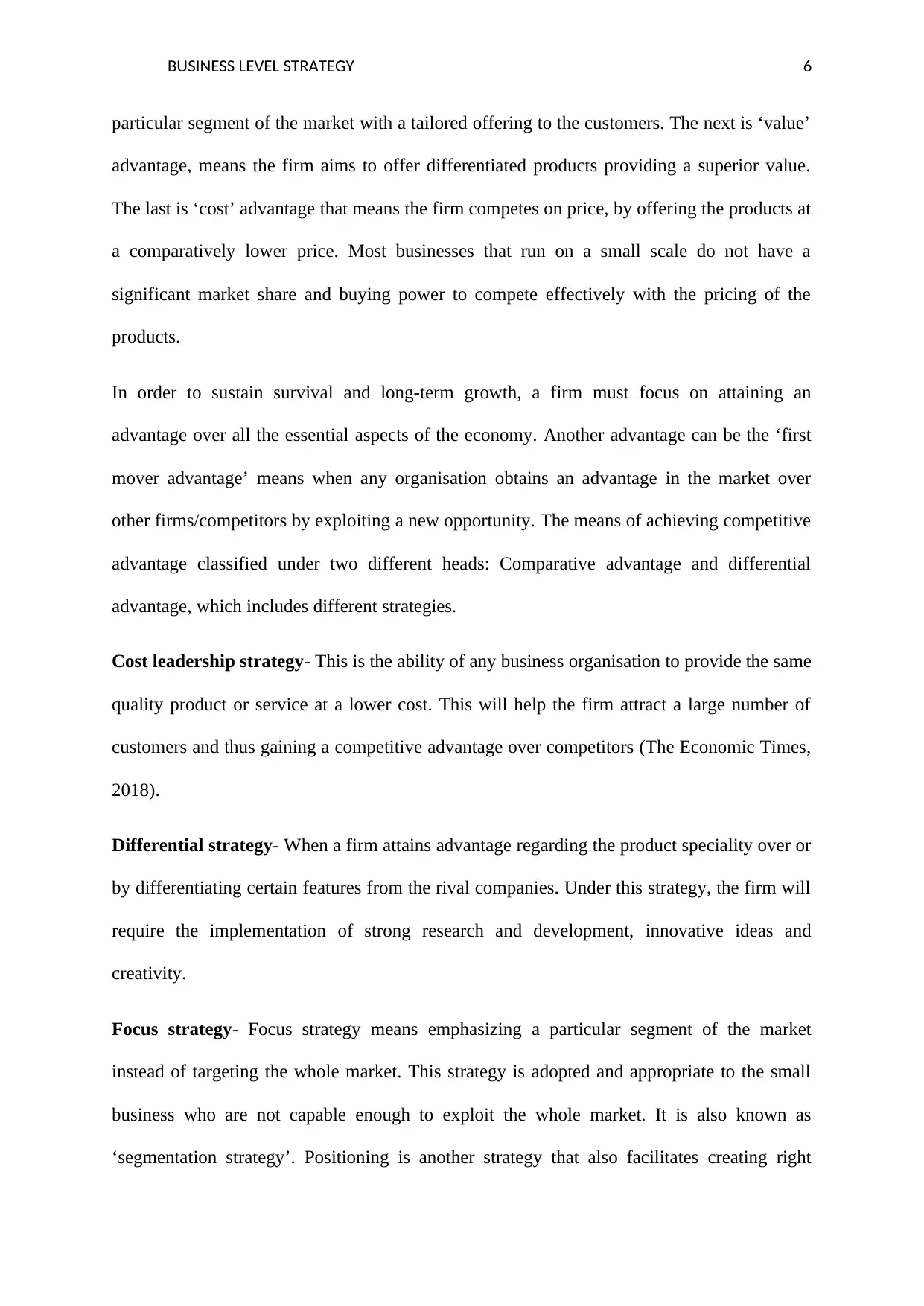
BUSINESS LEVEL STRATEGY 6
particular segment of the market with a tailored offering to the customers. The next is ‘value’
advantage, means the firm aims to offer differentiated products providing a superior value.
The last is ‘cost’ advantage that means the firm competes on price, by offering the products at
a comparatively lower price. Most businesses that run on a small scale do not have a
significant market share and buying power to compete effectively with the pricing of the
products.
In order to sustain survival and long-term growth, a firm must focus on attaining an
advantage over all the essential aspects of the economy. Another advantage can be the ‘first
mover advantage’ means when any organisation obtains an advantage in the market over
other firms/competitors by exploiting a new opportunity. The means of achieving competitive
advantage classified under two different heads: Comparative advantage and differential
advantage, which includes different strategies.
Cost leadership strategy- This is the ability of any business organisation to provide the same
quality product or service at a lower cost. This will help the firm attract a large number of
customers and thus gaining a competitive advantage over competitors (The Economic Times,
2018).
Differential strategy- When a firm attains advantage regarding the product speciality over or
by differentiating certain features from the rival companies. Under this strategy, the firm will
require the implementation of strong research and development, innovative ideas and
creativity.
Focus strategy- Focus strategy means emphasizing a particular segment of the market
instead of targeting the whole market. This strategy is adopted and appropriate to the small
business who are not capable enough to exploit the whole market. It is also known as
‘segmentation strategy’. Positioning is another strategy that also facilitates creating right
particular segment of the market with a tailored offering to the customers. The next is ‘value’
advantage, means the firm aims to offer differentiated products providing a superior value.
The last is ‘cost’ advantage that means the firm competes on price, by offering the products at
a comparatively lower price. Most businesses that run on a small scale do not have a
significant market share and buying power to compete effectively with the pricing of the
products.
In order to sustain survival and long-term growth, a firm must focus on attaining an
advantage over all the essential aspects of the economy. Another advantage can be the ‘first
mover advantage’ means when any organisation obtains an advantage in the market over
other firms/competitors by exploiting a new opportunity. The means of achieving competitive
advantage classified under two different heads: Comparative advantage and differential
advantage, which includes different strategies.
Cost leadership strategy- This is the ability of any business organisation to provide the same
quality product or service at a lower cost. This will help the firm attract a large number of
customers and thus gaining a competitive advantage over competitors (The Economic Times,
2018).
Differential strategy- When a firm attains advantage regarding the product speciality over or
by differentiating certain features from the rival companies. Under this strategy, the firm will
require the implementation of strong research and development, innovative ideas and
creativity.
Focus strategy- Focus strategy means emphasizing a particular segment of the market
instead of targeting the whole market. This strategy is adopted and appropriate to the small
business who are not capable enough to exploit the whole market. It is also known as
‘segmentation strategy’. Positioning is another strategy that also facilitates creating right
Paraphrase This Document
Need a fresh take? Get an instant paraphrase of this document with our AI Paraphraser
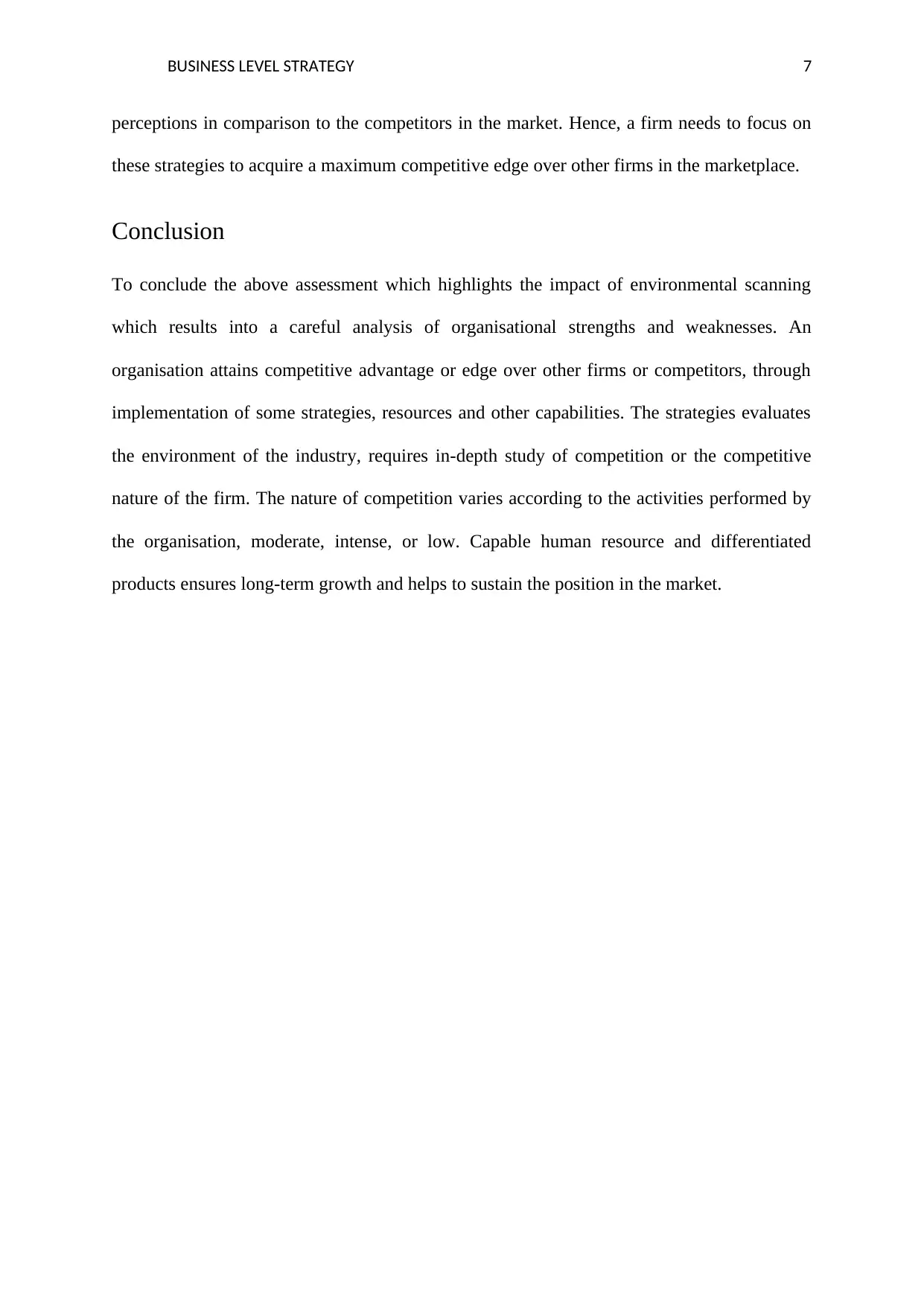
BUSINESS LEVEL STRATEGY 7
perceptions in comparison to the competitors in the market. Hence, a firm needs to focus on
these strategies to acquire a maximum competitive edge over other firms in the marketplace.
Conclusion
To conclude the above assessment which highlights the impact of environmental scanning
which results into a careful analysis of organisational strengths and weaknesses. An
organisation attains competitive advantage or edge over other firms or competitors, through
implementation of some strategies, resources and other capabilities. The strategies evaluates
the environment of the industry, requires in-depth study of competition or the competitive
nature of the firm. The nature of competition varies according to the activities performed by
the organisation, moderate, intense, or low. Capable human resource and differentiated
products ensures long-term growth and helps to sustain the position in the market.
perceptions in comparison to the competitors in the market. Hence, a firm needs to focus on
these strategies to acquire a maximum competitive edge over other firms in the marketplace.
Conclusion
To conclude the above assessment which highlights the impact of environmental scanning
which results into a careful analysis of organisational strengths and weaknesses. An
organisation attains competitive advantage or edge over other firms or competitors, through
implementation of some strategies, resources and other capabilities. The strategies evaluates
the environment of the industry, requires in-depth study of competition or the competitive
nature of the firm. The nature of competition varies according to the activities performed by
the organisation, moderate, intense, or low. Capable human resource and differentiated
products ensures long-term growth and helps to sustain the position in the market.
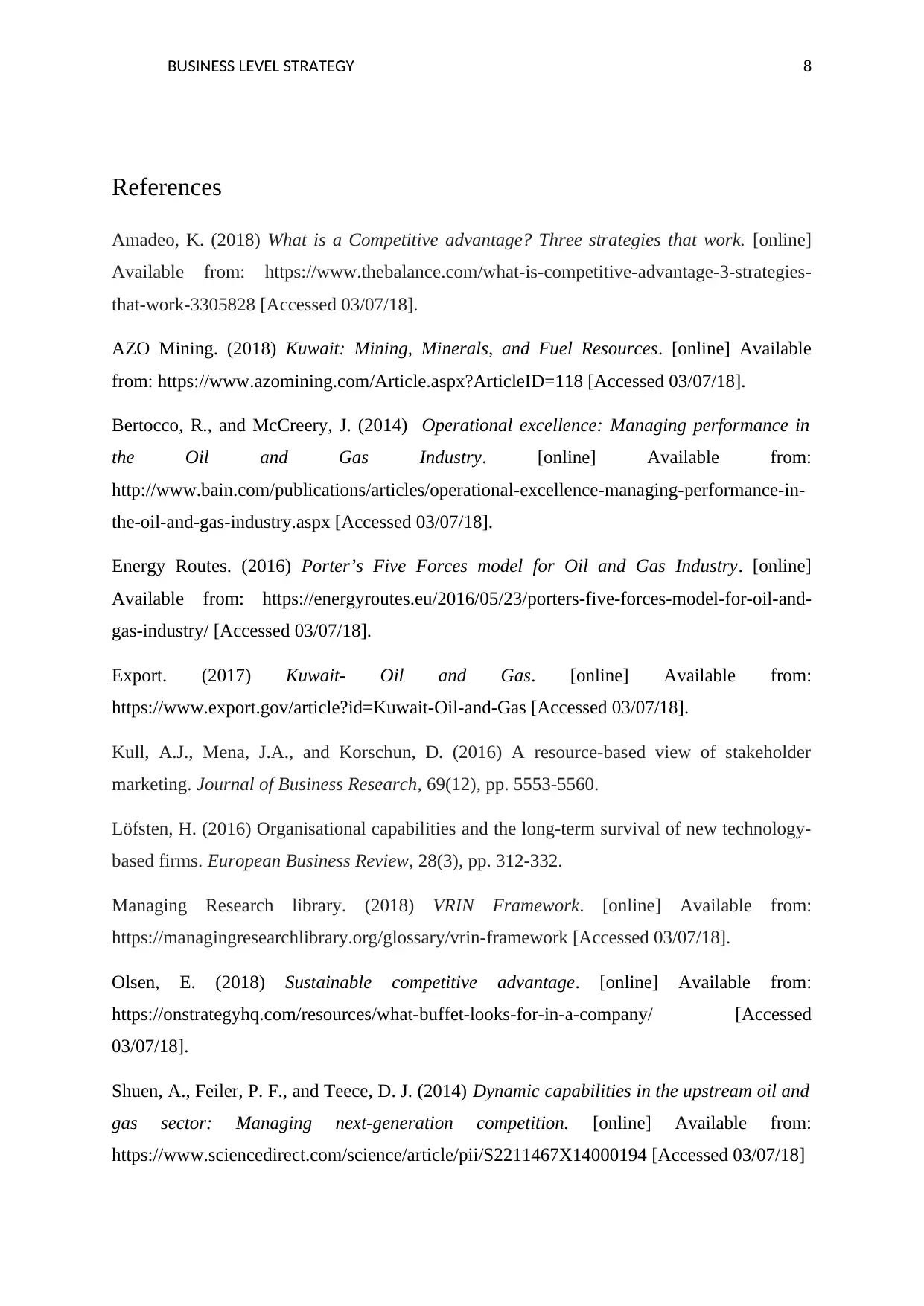
BUSINESS LEVEL STRATEGY 8
References
Amadeo, K. (2018) What is a Competitive advantage? Three strategies that work. [online]
Available from: https://www.thebalance.com/what-is-competitive-advantage-3-strategies-
that-work-3305828 [Accessed 03/07/18].
AZO Mining. (2018) Kuwait: Mining, Minerals, and Fuel Resources. [online] Available
from: https://www.azomining.com/Article.aspx?ArticleID=118 [Accessed 03/07/18].
Bertocco, R., and McCreery, J. (2014) Operational excellence: Managing performance in
the Oil and Gas Industry. [online] Available from:
http://www.bain.com/publications/articles/operational-excellence-managing-performance-in-
the-oil-and-gas-industry.aspx [Accessed 03/07/18].
Energy Routes. (2016) Porter’s Five Forces model for Oil and Gas Industry. [online]
Available from: https://energyroutes.eu/2016/05/23/porters-five-forces-model-for-oil-and-
gas-industry/ [Accessed 03/07/18].
Export. (2017) Kuwait- Oil and Gas. [online] Available from:
https://www.export.gov/article?id=Kuwait-Oil-and-Gas [Accessed 03/07/18].
Kull, A.J., Mena, J.A., and Korschun, D. (2016) A resource-based view of stakeholder
marketing. Journal of Business Research, 69(12), pp. 5553-5560.
Löfsten, H. (2016) Organisational capabilities and the long-term survival of new technology-
based firms. European Business Review, 28(3), pp. 312-332.
Managing Research library. (2018) VRIN Framework. [online] Available from:
https://managingresearchlibrary.org/glossary/vrin-framework [Accessed 03/07/18].
Olsen, E. (2018) Sustainable competitive advantage. [online] Available from:
https://onstrategyhq.com/resources/what-buffet-looks-for-in-a-company/ [Accessed
03/07/18].
Shuen, A., Feiler, P. F., and Teece, D. J. (2014) Dynamic capabilities in the upstream oil and
gas sector: Managing next-generation competition. [online] Available from:
https://www.sciencedirect.com/science/article/pii/S2211467X14000194 [Accessed 03/07/18]
References
Amadeo, K. (2018) What is a Competitive advantage? Three strategies that work. [online]
Available from: https://www.thebalance.com/what-is-competitive-advantage-3-strategies-
that-work-3305828 [Accessed 03/07/18].
AZO Mining. (2018) Kuwait: Mining, Minerals, and Fuel Resources. [online] Available
from: https://www.azomining.com/Article.aspx?ArticleID=118 [Accessed 03/07/18].
Bertocco, R., and McCreery, J. (2014) Operational excellence: Managing performance in
the Oil and Gas Industry. [online] Available from:
http://www.bain.com/publications/articles/operational-excellence-managing-performance-in-
the-oil-and-gas-industry.aspx [Accessed 03/07/18].
Energy Routes. (2016) Porter’s Five Forces model for Oil and Gas Industry. [online]
Available from: https://energyroutes.eu/2016/05/23/porters-five-forces-model-for-oil-and-
gas-industry/ [Accessed 03/07/18].
Export. (2017) Kuwait- Oil and Gas. [online] Available from:
https://www.export.gov/article?id=Kuwait-Oil-and-Gas [Accessed 03/07/18].
Kull, A.J., Mena, J.A., and Korschun, D. (2016) A resource-based view of stakeholder
marketing. Journal of Business Research, 69(12), pp. 5553-5560.
Löfsten, H. (2016) Organisational capabilities and the long-term survival of new technology-
based firms. European Business Review, 28(3), pp. 312-332.
Managing Research library. (2018) VRIN Framework. [online] Available from:
https://managingresearchlibrary.org/glossary/vrin-framework [Accessed 03/07/18].
Olsen, E. (2018) Sustainable competitive advantage. [online] Available from:
https://onstrategyhq.com/resources/what-buffet-looks-for-in-a-company/ [Accessed
03/07/18].
Shuen, A., Feiler, P. F., and Teece, D. J. (2014) Dynamic capabilities in the upstream oil and
gas sector: Managing next-generation competition. [online] Available from:
https://www.sciencedirect.com/science/article/pii/S2211467X14000194 [Accessed 03/07/18]
⊘ This is a preview!⊘
Do you want full access?
Subscribe today to unlock all pages.

Trusted by 1+ million students worldwide
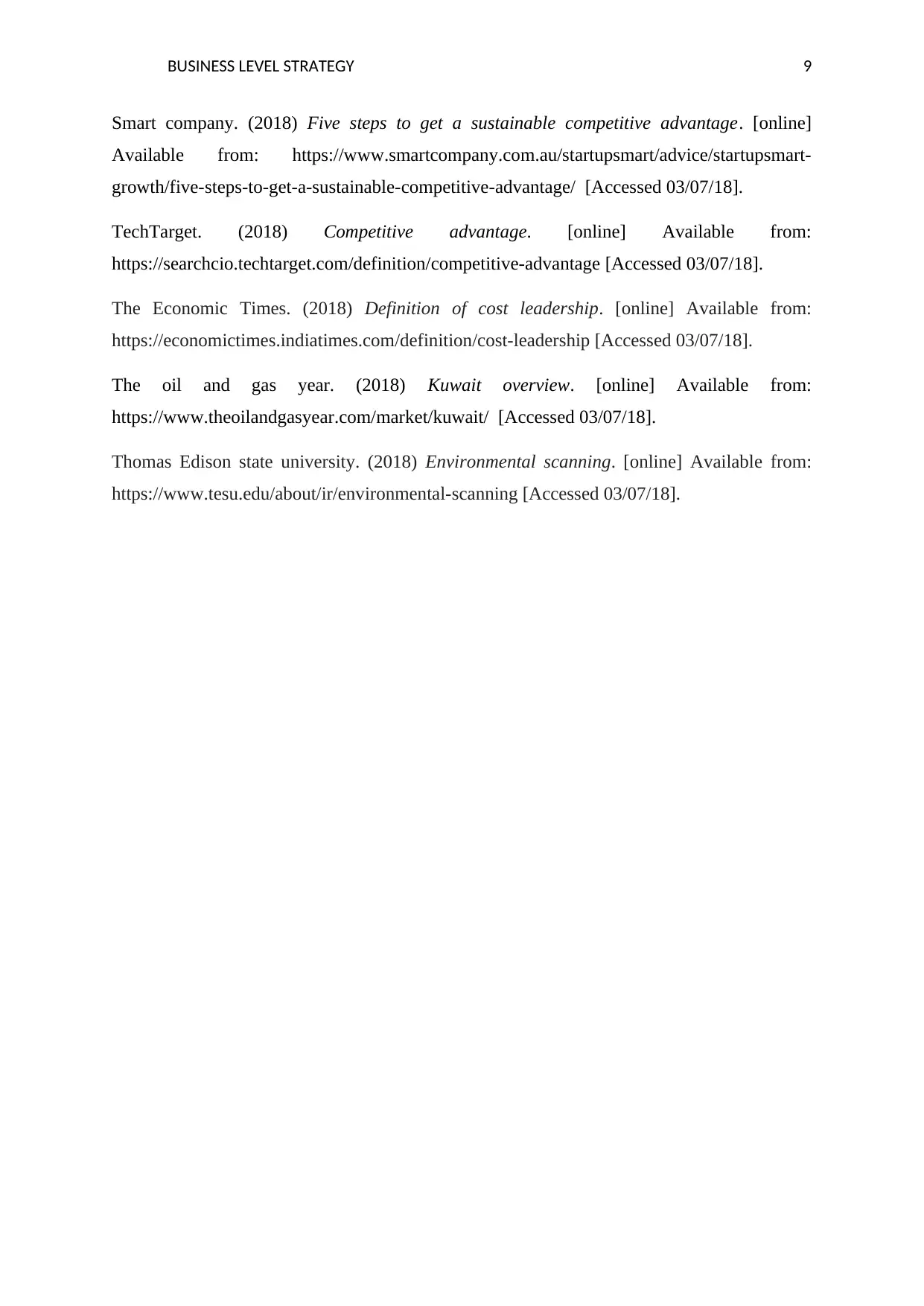
BUSINESS LEVEL STRATEGY 9
Smart company. (2018) Five steps to get a sustainable competitive advantage. [online]
Available from: https://www.smartcompany.com.au/startupsmart/advice/startupsmart-
growth/five-steps-to-get-a-sustainable-competitive-advantage/ [Accessed 03/07/18].
TechTarget. (2018) Competitive advantage. [online] Available from:
https://searchcio.techtarget.com/definition/competitive-advantage [Accessed 03/07/18].
The Economic Times. (2018) Definition of cost leadership. [online] Available from:
https://economictimes.indiatimes.com/definition/cost-leadership [Accessed 03/07/18].
The oil and gas year. (2018) Kuwait overview. [online] Available from:
https://www.theoilandgasyear.com/market/kuwait/ [Accessed 03/07/18].
Thomas Edison state university. (2018) Environmental scanning. [online] Available from:
https://www.tesu.edu/about/ir/environmental-scanning [Accessed 03/07/18].
Smart company. (2018) Five steps to get a sustainable competitive advantage. [online]
Available from: https://www.smartcompany.com.au/startupsmart/advice/startupsmart-
growth/five-steps-to-get-a-sustainable-competitive-advantage/ [Accessed 03/07/18].
TechTarget. (2018) Competitive advantage. [online] Available from:
https://searchcio.techtarget.com/definition/competitive-advantage [Accessed 03/07/18].
The Economic Times. (2018) Definition of cost leadership. [online] Available from:
https://economictimes.indiatimes.com/definition/cost-leadership [Accessed 03/07/18].
The oil and gas year. (2018) Kuwait overview. [online] Available from:
https://www.theoilandgasyear.com/market/kuwait/ [Accessed 03/07/18].
Thomas Edison state university. (2018) Environmental scanning. [online] Available from:
https://www.tesu.edu/about/ir/environmental-scanning [Accessed 03/07/18].
1 out of 10
Related Documents
Your All-in-One AI-Powered Toolkit for Academic Success.
+13062052269
info@desklib.com
Available 24*7 on WhatsApp / Email
![[object Object]](/_next/static/media/star-bottom.7253800d.svg)
Unlock your academic potential
Copyright © 2020–2025 A2Z Services. All Rights Reserved. Developed and managed by ZUCOL.





